
A group of MIT researchers who use AI to mitigate traffic congestion applied ideas from that domain to tackle the problem of multiple robots in a warehouse setting.
By breaking an intractable problem into smaller chunks, a deep-learning technique identifies the optimal areas for thinning out traffic in a warehouse.
Hundreds of robots zip back and forth across the floor of a colossal robotic warehouse, grabbing items and delivering them to human workers for packing and shipping. Such warehouses are increasingly becoming part of the supply chain in many industries, from e-commerce to automotive production.
However, getting 800 robots to and from their destinations efficiently while keeping them from crashing into each other is no easy task. It is such a complex problem that even the best path-finding algorithms struggle to keep up with the breakneck pace of e-commerce or manufacturing.
AI-Driven Solutions for Efficiency
In a sense, these robots are like cars trying to navigate a crowded city center. So, a group of SciTechDaily